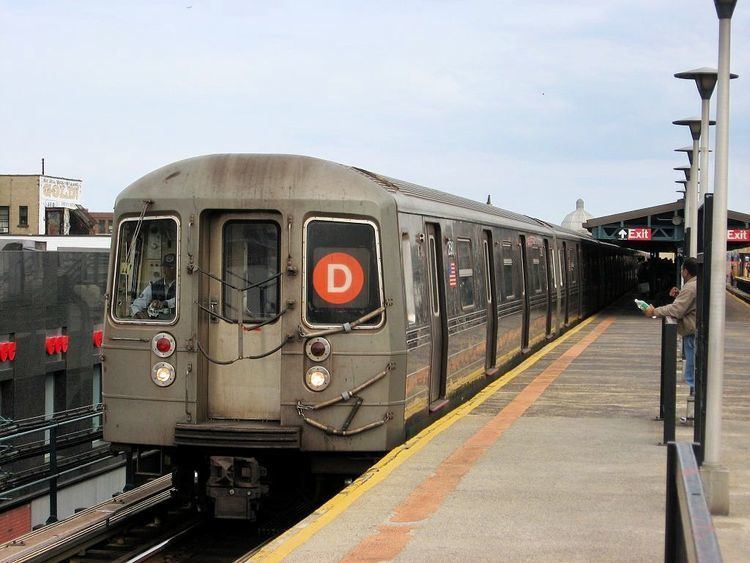In service 1986-present Constructed 1986–1988 | Family name SMEE | |
 | ||
Manufacturer Westinghouse-Amrail Company: Westinghouse, ANF Industrie (all cars)
Jeumont Schneider (2500-2724), Alsthom (2725-2924) Replaced Many R10s, remaining R16s, many R27s, and some R30s Entered service April 13, 1986 (under testing)
June 20, 1986 | ||
The R68 is a B Division New York City Subway car order consisting of 425 cars built by the Westinghouse-Amrail Company, a joint venture of Westinghouse, ANF Industrie, Jeumont Schneider, and Alsthom. The cars were built in France from 1986 to 1988 and shipped through New York Harbor.
Contents
Description
The R68 was the third R-type contract to be built with 75-foot (22.86 m) cars (the previous two being the R44 and R46), which have more room for sitting and standing passengers per car than the 60-foot (18.29 m) cars that were used previously and afterward. The cars, numbered 2500–2924 cost about $1 million each and they replaced many R10s dating from 1948, all remaining 6300-series R16s dating from 1954 to 1955, and some R27s and R30s dating from 1960 to 1962. The cars are built with stainless steel, and are graffiti-resistant.
On October 15, 1982, the Metropolitan Transportation Authority announced that it would purchase 225 cars from Westinghouse–Amrail. The first of the 225 cars were initially scheduled to arrive in January 1985, with the entire order complete in May 1986. The projected cost of the order was $210 million, or about $933,000 per car.
Initial Problems
The R68's manufacturers suffered from significant system integration problems. Poor communication and coordination between the carbody builder (ANF Industrie) and the chassis assembler (Westinghouse) led to operational failures. Due to this, the R68s became known as a "lemon." During the beginning of service, the R68s had problems with malfunctioning doors, faulty wiring, electrical controls that suddenly lost power, and malfunctioning air brakes. In addition, the fleet had a high breakdown rate. Another problem occurred on November 11, 1986 when a train of R68s failed to climb the grade on the Manhattan Bridge. However, extensive work performed by the New York City Transit Authority provided solutions to the fleet's many problems.
The MTA was given a second option order of an additional 200 subway cars from Westinghouse-Amrail, but due to problems from the manufacturer, the MTA awarded it to Kawasaki. Westinghouse-Amrail offered to have the 200 cars built for $1,012,000 each, while Kawasaki agreed to have them built for $958,000 per car. This order became the R68A.
Delivery and Revenue Service
The delivery of the first R68s was made on February 4, 1986, but it failed to pass a sharp curve on the South Brooklyn Railway trackage on 38th Street in Brooklyn, and as a result the curve had to be rebuilt and the radius eased somewhat, and the delivery took place on February 26, 1986. The 30-day acceptance test for the R68s began on the Brighton Line on April 13, 1986. The R68s' first entry to revenue service was on June 20, 1986 on the Brooklyn half of the divided D train with the first fleet consisting of cars 2500-2507. There were two contracts to supply the R68 fleet. The primary order consisted of cars 2500-2724 while the option order consisted of cars 2725-2924. The R68, therefore, became the first subway fleet to have an option order.
The R68s are based out of the Concourse Yard in the Bronx and the Coney Island Complex in Brooklyn and assigned to the B, D, G, N, W and Franklin Avenue Shuttle. The R68s that operate on the Franklin Avenue Shuttle have some noticeable differences from the main line cars. These cars have permanent side signs instead of rollsigns, remain set up as single units with OPTO switches added (unlike the rest of the R68s, which have been configured into sets of four), and car 2923 has three-piece side windows.
Replacement
The R68s are scheduled to remain in service until at least 2025 - 2030 and the MTA is proposing mid-life technological upgrades for the fleet including LED destination signs and automated announcements. Test LED lights from the China Railway Rolling Stock Corporation have been installed on cars 2860-2863; the test cars with these displays, which give out the date and time, are now running on the G route. However, the displays do not indicate the next stops along the routes, and it is unlikely that technological improvements will be implemented in the near future.
